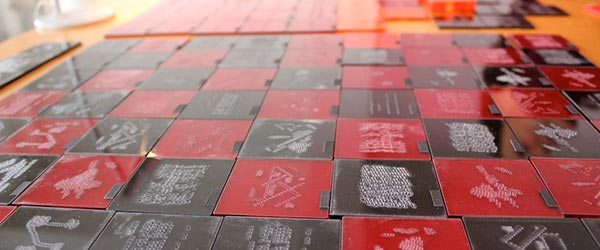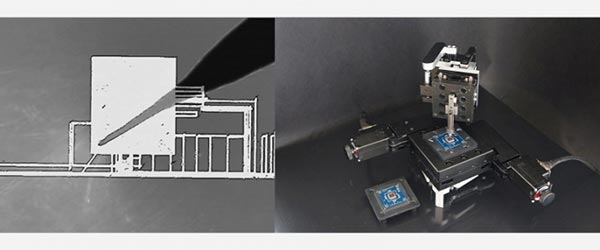In 2019, we start our Fablab Residency program! If you're an artist, designer, engineer or developer and want to develop a new creative project with our digital manufacturing machines, Fablab.iMAL can offer you a residency!
Interested? More here.

Suzanne Treister was born in London in 1958. Trained as a painter, she uses various supports, including video, internet and interactive technologies, photography and drawing. Between 1997 and 1999, she wrote, designed and developed a unique cd-rom accompanied with a book: No Other Symptoms – Time Travelling with Rosalind Brodsky.
After frequently going to arcades in the 80s, and creating imaginary games start screens on her Amiga in the early 90s, Suzanne Treister created an alter-ego, Rosalind Brodsky, a time traveller working for the Institute of Militronics and Advanced Time Inverventionality in the 21st Century. Brodsky investigated military research projects led by this imaginary institute, which led in 2006 to the HEXEN 2039 project, an investigation on the development of new "mind control" technologies, through diagrams, drawings and photographs. Treister carried on her exploration of information technology genealogy in HEXEN 2.0, leaving the fictional aspect to focus on the development of cybernetics, computer and internet history, and the rise of the control society.
http://www.suzannetreister.net/suzyWWW/No_Other_Symptoms/contents.html http://www.suzannetreister.net/suzyWWW/CDROMinfo.html
Before Rosalind Brodsky, you were making fictional videogame stills or designing imaginary software packages. What gave you the idea of making an art work on cd-rom?
The start of the Rosalind Brodsky project in 1995 took the form of a biographical narrative alongside a group of fabricated time travel costumes and devices. In 1996 I started the Brodsky website which included an extensive time travelling diary and the beginnings of work in other media like sound and video. Given the huge amount of material I was developing for the project in so many various media a cd-rom seemed the inevitable way to go, to bring it all together into a navigable, time-based but non-linear space.
it was an exciting glitch in time, a genuine attempt to bring together all media into one format
Did you consider the cd-rom as a new kind of storage or a new media? Was there something like cd-rom art?
At the time I started the cd-rom I was storing my files on zip drives, cd drives were not really easily available yet. So I didn't see them at all as storage devices. I'm not sure when I got my first cd burner to make a test disc. Much later I think. But yes there was cd-rom art. I'm not sure if I had actually seen any for real when I started mine, but there was some emerging rhetoric on various listservs. People started to use the term interactive multimedia for this kind of work and later there was a lot of argument about how truly interactive each cd-rom actually was, whether a work allowed user generated feedback/content or not, or whether it was a click and move around thing like an early website, the former being the more politically attractive cool option for most. Funny that now everything has ended up online the 'cool' user generated stuff ends up at the NSA. But back then it was I guess connected to the relational aesthetics ideals that were also taking root in the mainstream art world. Weirdly though, an art cd-rom could not store user data as it's a burnt disc. ROM stands for Read Only Memory.
What was appealing with the CD-rom format for an artist?
It was really exciting being able to make a computer game-like space where the user could virtually move through the environment you'd created, where they could enter rooms, play videos, where you could use sound, images, text, animation and more or less anything you wanted in any configuration in multi dimensional layers to be entered, navigated and discovered. The novelty of it all was euphoric and liberating and it was positively challenging learning how to use the cd-rom authoring software Director. New ideas would appear possible more or less on waking every morning.
Has there been a particular CD rom that you liked or was very inspiring for you?
Not in particular. I was working in South Australia at the time and didn't have the cash to travel to all the international new media festivals where they were on show. I eventually saw a few but wasn't that excited by them. I think pehaps it was more exciting to make your own than navigate other people's.
One issue looking at it now was that if you wanted to see these works you had to go to an exhibition space and time was limited, you didn't know how long you needed for each work, they really were more suited for home use like a book but they weren't easily available to buy. A friend I knew in Sydney later set up a website to sell them, shortly before the whole cd-rom hype collapsed. I estimated my cd-rom would take about 3 hours to get through and so I started showing it projected large with a mouse on a stand at the back of a darkened space, with info on how long you might need to spend to see it all and when it came out I displayed the accompanying book as a guide. This made for a more immersive experience for the audience. But thinking back, the real inspiration came from computer games which I had been making work about since the late 1980s. I'd followed their development from the basic ones that existed when I was a kid, to the VR helmet games I played upstairs in the Trocadero in London in the 1980s, up to the lastest games like Myst and Riven which came on cd-rom, and was excited by the idea of being able to make an art work with those kind of virtual interactive navigable spaces but with my own invented narrative and ideas.
The CD rom was published by Black Dog publishing. Was CD rom a way to talk to another audience? What kind of problems did you encounter to distribute and make this artistic creation on CD rom find its place on the shelves?
I was lucky to get funding from the Australian Film Commission to produce the cd-rom and from the Australia Council for the book counterpart. This made it easier to find a publisher and for the work to move outside the new media world and into bookshops all over the world. It also made it collectable, distributable and archivable by libraries and universities.
Were you at that time already conscious of the rapid technical obsolescence? Is the fact that you are now working almost exclusively with paper and ink related to this?
I was aware that the technology would move on and that the cd and software may not always be operable. Having spent years on this project I was keen to make a book version of it so that it would remain visible in another, albeit linear, form. I also wanted to make the book as a kind of guide as the cd-rom had so many areas to navigate people could miss many of them if they didn't discover all the pathways.
This wasn't the reason for my return to more traditional media, that was because I got sick of the techno arms race and the increasing corporatisation and governmentisation of the world wide web and the internet. I decided to mostly step aside from using the actual new technologies in order to discuss them in my work.
How do you analyse afterwards the failure of this medium?
In the 1990s some people thought cd-roms would become the new film, that's why the Australian Film Commission was giving out so much funding in the area. Clearly this didn't happen and the internet developed many of the capabilities of cd-roms. I've mentioned some other drawbacks above.
What is the legacy of those experiments for the contemporary creation and for the digital edition? What are its descendants?
Well there are still video games being made which work in similar ways and are still widely distributed in disc format. I haven't seen the kind of space which happened on my cd-rom appearing in any other format, media, or online, in terms of art. When it comes to the internet, even though many of us now spend forever on it, we are impatient, we no longer want to find the invisible link to navigate to the hidden page or the stream of unintelligible data (as was the case in some early net art), nor do we usually want to remain within a single site for long, unless we are watching a film etc. Corporate design took over the aesthetics of navigation. Maybe web surfing in general – the kind where you are on a voyage of discovery rather than a shopping chatting tweeting trip - provides a kind of cd-rom experience? Not really though. An artist's cd-rom used to be a complete enclosed work. For me my cd-rom was like a multi-media virtually immersive novel/film, where user generated content was in the mind of the viewer, for them to take away with them, rather than input back into the work.
Do you think it is important to preserve those born digital contents? And if so, under what form?
Yes of course, it was an exciting glitch in time, a genuine attempt to bring together all media into one format. I think if this cd-rom web based emulator software you were talking about could work that would be great. If there were somewhere I could upload my original files so that the work could be navigable online exactly as it was on cd-rom I would do it for sure.
Interview by Marie Lechner, journalist specialised in digital cultures, and researcher at Pamal (Preservation-Archeology-Media art Lab) at the École Supérieure d'Art in Avignon (pamal.org)

A historical selection of art & culture cd-roms and electronic artworks published on floppies, mostly produced in the 90s highlighting the short life of born-digital art. It presents early pioneering works in new media and digital arts, conveying many visions and utopias around the upcoming digital world as well as remarkable explorations of interactive digital media.
WELCOME TO THE FUTURE
- Visions, Utopias & Politics
- New Art Forms
- Documenting Contemporary Art
- Digital Heritage
- All interviews
In 2019, we start our Fablab Residency program! If you're an artist, designer, engineer or developer and want to develop a new creative project with our digital manufacturing machines, Fablab.iMAL can offer you a residency!
Interested? More here.

In the context of Transmediale festival in Berlin, Wallonia Brussels International organises an exhibition showing pieces by 3 Brussels-based artists: Felix Luque, Julien Maire and LAb[au].
iMAL is very happy to be associated with this event as the co-producers of Julien's new work Composite as well as Felix's installations D.W.I. and Memory Lane.

Signals:...
The time has finally come: our renovation works at 30 Quai des Charbonnages started last week! After some demolition works, we can start building up our new, 3-storey centre for thedigital art and culture, which will open autumn 2019. Follow us on instagram,...
This page is an archive of the iMAL website that operated between 2010 and 2019. It compiles activities and projects made since 1999.
For our most recent news and activities, please check our new website at https://imal.org
asbl iMAL vzw - 30 Quai des Charbonnages Koolmijnenkaai 30 - 1080 Bruxelles Brussel 1080 - 32 (0)2 410 30 93
